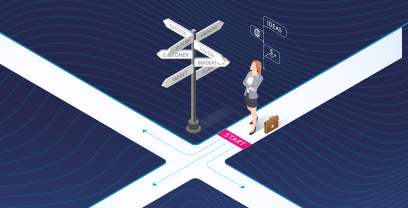|
The Forrester Wave™: Supplier Value Management Platforms, Q3 2024 See Report
Blog »
Why Agility and Creativity are the New Vital Procurement Drivers (but don’t sacrifice “effectiveness”)

If Procurement people, functions and organisations are going to be successful, it is obvious that we have to adapt to the changing wider business and social environments. Remember that Darwin did not actually talk about the “survival of the fittest” – he talked about the “survival of the best-adapted”.
We haven’t been bad at adapting over recent decades. Whilst we might question why there aren’t more CPOs on the Board and so on, there are far more Procurement professionals than 50 years ago, and the profession is much better recognised and established. However, past moderate success is no guarantee of the future, particularly as the pace of change just seems to accelerate every day. So when we look at what our organisations want from Procurement, it is worth considering some high-level imperatives.
Of course, value is ultimately what it is all about, but the question is how Procurement should focus its efforts to generate that value we all believe Procurement can provide. And it seems that increasingly three topics come to the fore – effectiveness, creativity and agility.
Effectiveness covers what we might consider the traditional aspects of Procurement. Effectiveness is a better word than “efficiency”, of course. The task of processing thousands of purchase orders may be executed “efficiently”, but there may well be more effective ways of managing this need – for instance, users having access to online guided buying catalogues. So effectiveness means Procurement meeting the needs of the organisation, identifying and delivering the key activities and services that are needed at minimum cost, and working in a structured, productive manner.
Being effective is really the base level of expectation for a Procurement function today, we would argue. But then we move on to our two other targets – agility and creativity, which define where Procurement needs to go in order to sustain its contribution into the future.
Agility means responding quickly to internal and external opportunities. It means working with stakeholders at the pace they and the business need to work at, not at a pace defined by historical Procurement processes and tools. It means being proactive in keeping colleagues informed about progress, rather than work disappearing into the Procurement “black hole” until the sponsor starts banging on the department’s door.
Agility means finding, assessing, selecting, onboarding, contracting and going live with suppliers rapidly and in a manner that is as painless as possible for everyone. Agility means the flexibility to change the nature of what is being bought if the requirements change – with a direct link from the sales side of the business back through Procurement to suppliers and the supply chain. All of this requires the right technology, technology that reflects and supports that agility, that can be flexible and evolve as users’ needs change. But agility also requires the right attitude, and of course we need agile suppliers too – but that’s another story!
Like agility, creativity applies to both the way Procurement works and perhaps even more so to suppliers. Our task in Procurement is to find and embrace value-creating creativity amongst our supplier base, and to do that well, we may need to be somewhat creative ourselves. The realisation that innovation from suppliers is a huge strategic opportunity for most organizations has been slow to dawn, but now we see these concepts rapidly becoming more and more accepted. Indeed, they are becoming as much part of the Procurement play-book as “cost savings” and “stock management”.
So being open to new, smaller, innovative potential suppliers, being able to find them, engage, test out ideas and share some risk and benefits are all becoming central approaches for Procurement functions and the wider organisation. The aim in the private sector must be to capture innovation from the supply markets faster and more successfully than others, to drive our competitive advantage. In the public sector, it is about finding innovation which can ultimately benefit the citizen and taxpayer.
Putting our three imperatives together, it is clear that innovative, collaborative and fast-moving projects involving buyers and suppliers will be the norm, yet these activities will also need to be effective, which means controlled, disciplined and recorded. That’s another area in which technology will assist.
“We’ve always used these suppliers / done things this way / used this system / bought these goods and services” is no longer an acceptable stance for Procurement. If we don’t take this on board, our colleagues, who desperately need effectiveness, agility and creativity to sustain the business in these disruptive times, will simply move on and leave Procurement behind.
©Peter Smith
August 2019


